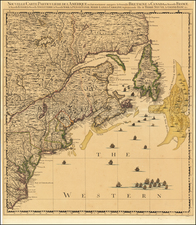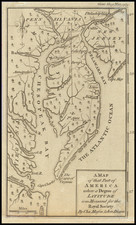A foundational document of Colonial America, with the first printed map of a North American City.
William Penn's Letter… (1683) includes the first printed map of the city and the earliest design for a planned community in America. It is a critical primary document relating to the foundation of Pennsylvania, and one of the most important 17th Century imprints relating to America. The map is accompanied by the printed Letter... by William Penn, Pennsylvania's founder, explaining and promoting his new colony to prospective investors and settlers. It also includes the original Advertisement... by Thomas Holme, Penn's official surveyor, explaining his map of Philadelphia.
The following is a link to the map: /gallery/enlarge/37576a
William Penn, Thomas Holme and the Foundation of Philadelphia
William Penn (1644-1718) was a Quaker convert and the son of English Admiral Sir William Penn (1711-70). Much of Penn's early adulthood had been spent promoting Quakerism, a doctrinally strict but, in many ways, socially enlightened sect of Christianity. While estranged from his father and persecuted by royal authorities over his religious beliefs, Penn nevertheless inherited his father's estate and the large debt owed to Sir William by Charles II. In lieu of repaying the debt in cash, the king offered Penn the opportunity to create a proprietary colony in North America. The area that is now southeastern Pennsylvania had previously been settled by the Swedes and Dutch, but had been under English rule since 1665. In July 1681, Charles II formally granted Penn a charter entitling to him to a large swath of territory running from the west bank of the Delaware River, through the interior of the continent (supposedly as far as the Pacific), roughly between 39o30' and 42o North.
Penn quickly dispatched three agents (called "Commissioners") to America scout out his new colony, which he named Pennsylvania (meaning 'Penn's Woods'), and to locate a site for a capital city. The site chosen was an unsettled area of high ground between the Delaware and Schuylkill Rivers, known to the local Lenape people as Coaquannock (meaning "pine grove"). The commissioners purchased the land from local Swedish settlers and made a report to Penn, who approved the location.
Penn had grand and idealistic ambitions for the new colony, built around his Quaker values of hard work, pacifism, charity, and religious tolerance. He fittingly named the new capital Philadelphia (meaning "Brotherly Love" in Greek), after a city in Asia Minor mention in Revelation in the New Testament. Unlike other English American colonial towns which had developed orgnaically, such as Boston, New York and Charleston, Penn's envisioned "greene country towne" was to be built according to a meticulous plan, following enlightened precepts. Before leaving England for Pennsylvania in April 1682, Penn appointed his friend, Thomas Holme, to create the plan for Philadelphia.
Thomas Holme (1624-95) was an experienced estate surveyor, having worked in both England in Ireland, and prominent member of Penn's Quaker circle. He was born in Lancashire and served in the Parliamentary Army during the English Civil War. He likely met Penn and converted to Quakerism while both lived in County Wexford, Ireland in the 1660s. Appointed as the Surveyor General of Pennsylvania, Holme arrived in the province in August 1782, and served as one of Penn's key lieutenants for the rest of his days.
In consultation with Penn, Holme settled on a rectangular grid and square plan for Philadelphia. Such a geometric layout was by no means a novel concept. In fact, it had been favored by the Ancient Romans who built the majority of their towns on some form of this concept. While the geometric grid fell out of favor during the Medieval Era, the concept was revived by Renaissance planners. Indeed, by the 17th Century many important cities, notably Turin, Italy, were rebuilt on a grid plan.
The impetus for reviving the rectangular grid plan in England was the Great Fire of London of 1666. Pre-Fire London consisted of a Medieval warren of narrow streets. Not only did this convoluted and congested plan help spread the plague, but it ensured that the city went up like a tinderbox following as small fire in a bakery. While London was rebuilt on its ancient plan, the tragedy spurned many of London's leading minds, including John Evelyn, Robert Hooke and Christopher Wren (all acquaintances of Penn) to formally investigate new designs of urban planning. While the solution of a rectangular grid was not always followed, it was generally agreed that a city should feature wide streets in some form of regular pattern and that built-up areas should be interspersed with ample greenspace. Philosophically, the appreciation for a rational urban design prefigured the ethics of the Enlightenment period that was soon to follow. This was viewed to be beneficial for reasons of fire prevention, public health, transportation and ease of surveying.
Both Penn and Holme were greatly enamored with these concepts which employed "well-ordered spaces", as it accorded perfectly with their Quaker ideals of creating a disciplined, healthful, and and humane society. Holme developed the present map as a blueprint for Philadelphia's future development. As noted in Holme's Advertisement that accompanied the map, Holme believed that the natural location of Philadelphia was magnificent, as "such a situation is scarce to be paralleled."
In developing Philadelphia's five public squares, Holme explicitly mentions that he was inspired by Moorfields, a large public garden in northeast London, that had long brought much pleasure to the city's inhabitants. As conceived by Holme, even the proprietors on the smallest designated property lots in Philadelphia would have "about half an acre" of land which would be "room enough for a house, garden, and small orchard, to the great content and satisfaction of all here concerned", luxuries almost unimaginable in London.
The only major disagreement between Penn and Holme revolved around the naming of the streets (other than Broad and High Streets). Holme wanted to name the thoroughfares after prominent individuals, however, Penn thought that the memorialization of men was against the Quaker value of modesty. The proprietor's view prevailed, and many streets were named after trees, such as Chestnut, Locust, Mulberry and Walnut, names that continue to this day.
The founding Pennsylvania is generally considered to be one of the smoothest and most successful rollouts of a new colony in British history. Penn's marketing campaign was highly effective in attracting settlers to Pennsylvania. He also proved to be a good administrator, ensuring that the colony prospered in its early years. Impressively, the colony's population grew from 600 in 1683 to 11,400 in 1690. Thomas Holme's A Mapp of Ye Improved Part of Pensilvania (1687) charts the early success of the colony, as it shows how the province had developed in the greater region surrounding Philadelphia, employing a reduced version of the present map as an inset.
Holme's plan was, more or less, implemented and today downtown Philadelphia's street pattern closely follows that which is proposed on the present map. In fact, Philadelphia's city limits occupied the original boundaries as proscribed by Holme until 1854. However, while the orderly street grid and public squares were built as planned, the city's inhabitants did not fully cooperate with the Penn and Holme's concept of a spacious city. Almost immediately after taking possession of their properties, the owners of the prime lots along the Delaware River began to subdivide their lands and sell off small parcels to waiting buyers. This resulted in the creation a heavily congested corridor of settlement along the Delaware riverfront. While development eventually spread into the interior along Market Street, the notion that each household would preserve an "orchard" in their backyard was revealed to be somewhat fanciful. That being said, Philadelphia developed into the largest and most important city in Colonial America and serve as the first capital of the United States during the War of Independence.
Holme's plan for the city was much admired and influenced the plans for new colonial cities, such as Kingston, Jamaica (1693), Savannah, Georgia (1733) and New York City's expansion beyond its old Dutch boundaries (1770s onwards). As the first model for a planned city in America, it is a milestone in the history of urban America.
Notably, Holme's map was engraved by John Thornton (1741-1708), one of the greatest English mapmakers of the era, being the official cartographer to the Hudson's Bay Company and the publisher of T he English Pilot, Fourth Book (1689), the first sea atlas dedicated to England's American colonies.
The Rarity of Holme's Portraiture and William Penn's Letter
The present map appeared within a pamphlet, entitled A letter from William Penn proprietary and governour of Pennsylvania in America, to the Committee of the Free Society of Traders of that province, residing in London... (London, 1683). The pamphlet was issued in the autumn of 1683 in three different editions, each "printed and sold by Andrew Sowle, at the Crooked-Billet in Holloway-Lane in Shoreditch, and at several stationers in London". The different editions can be distinguished by minor differences in pagination and typography, although the content of all three are the same. All of the editions consist of four parts after the title; 1) Penn's Letter...; 2) Holme's Advertisement... explaining the map; 3) Holme's map, the Portraiture...; and 4) an index to the property owners in Philadelphia, corresponding to numbers on the map.
William Penn's Letter to "the Committee of the Free Society of Traders of the Province" (meaning prospective investors and settlers in the Pennsylvania scheme), dated Philadelphia, August 3 1683, is both historically important and a fascinating read. It is nothing short of an ebullient and detailed disquisition extolling the innumerable virtues of Pennsylvania. While some liberties were clearly taken, including comparing Philadelphia's climate to that of the South of France, the arguments presented are well written, carefully ordered and, most of all, convincing. The Letter was a key part of Penn's successful marketing campaign to establish the colony.
The manuscript for Holme's map and the other contents of the pamphlet were drafted in Philadelphia in August 1683, and then hastily dispatched to London. The map and pamphlet were then quickly engraved (the map by John Thornton and the text by Andrew Soule), and distributed to Penn's investors and prospective settlers. It was not unusual for contemporary London printers, such as Soule, to issue multiple editions of the same pamphlet, as the copper plates wore down and needed to be altered. While perhaps as many as 300 examples of the pamphlet were originally issued, the work was sold without a binding (leaving it exposed to damage), would have been heavily used, and treated as ephemera, so accounting for its low survival rate.
Importantly, while Holme's map is present, and is complete in and of itself, the pamphlet to which it belongs is otherwise incomplete.









![[A chart of New York Island & North River: East River, showing passage through Hell Gate, and the North Shore of Long Island: Flushing Bay, Hampstead Bay, Oyster and Huntington Bay, Cow Harbor]](https://storage.googleapis.com/raremaps/img/small/51531.jpg)

![[The First Maps Printed Color] Cartes en Couleur des Lieux Sujets aux tremblements de Terre Dans toutes les parties du Monde Selon le Sisteme de l’impulsion Solaire](https://storage.googleapis.com/raremaps/img/small/52293op.jpg)

![[Rare First State] Novissima Tabula Regionis Ludovicianae Gallice dictae la Louisiane . . .](https://storage.googleapis.com/raremaps/img/small/72622.jpg)
![[Right sheet only of: A New Chart of America Florida to New York with the Principal Harbours on a Large Scale, Drawn from the latest Authorities, by Robt Blachford. 1807.]](https://storage.googleapis.com/raremaps/img/small/55819.jpg)